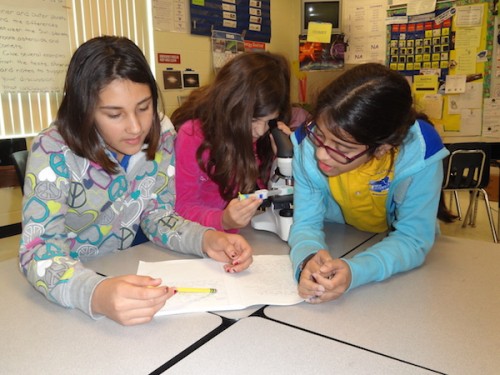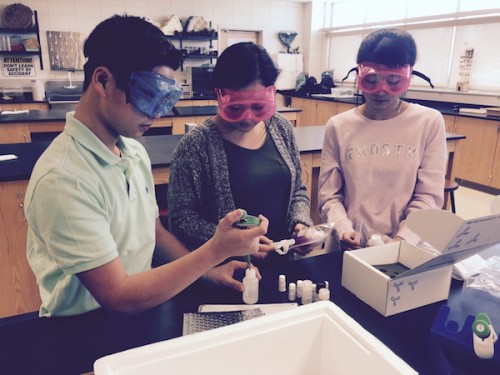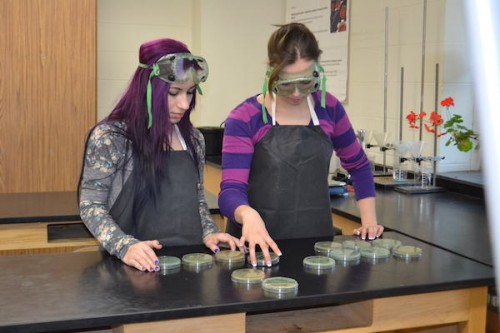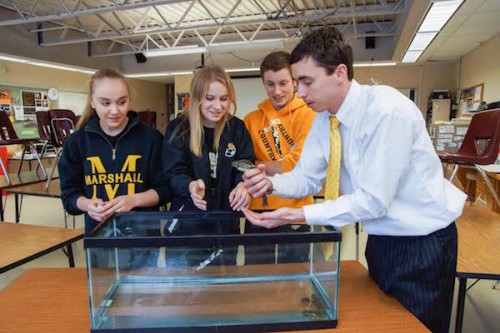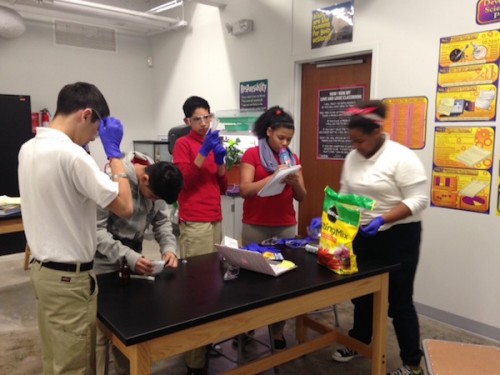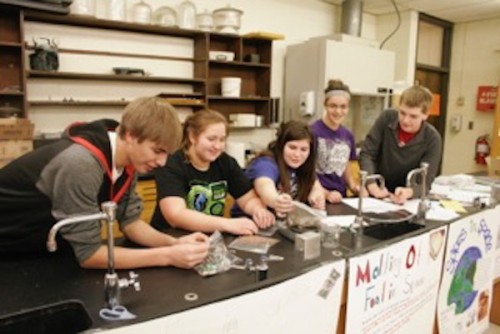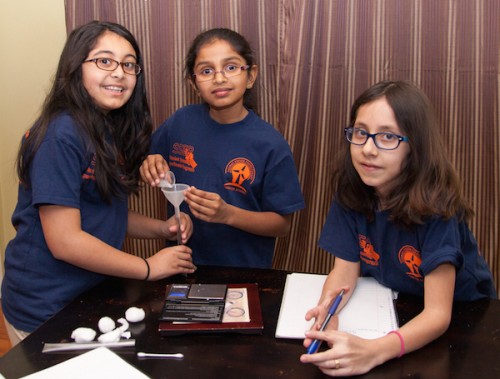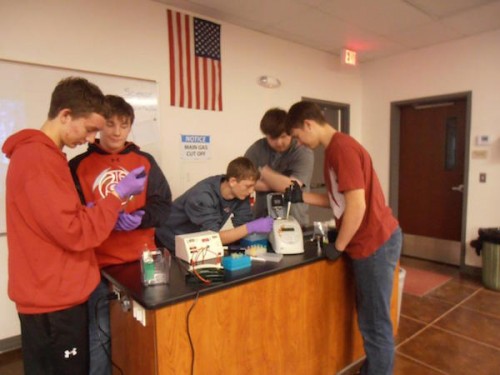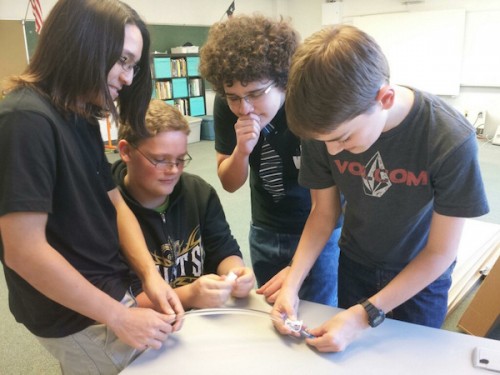The Student Spaceflight Experiments Program is proud to report that there were a total of 2,521 proposals submitted from student teams across the 24 communities participating in Mission 7 to ISS. Of those, 898 proposals were forwarded for review by Step 1 Review Boards in each of the communities. Each Step 1 Review Board selected three finalist proposals, which were submitted to the National SSEP Step 2 Review Board.
On December 9 and 10, 2014, the Step 2 Review Board met at the Smithsonian National Air and Space Museum, reviewed all 72 finalist proposals, and selected one proposal to fly for each community, for a total of 24 flight experiments. By December 17, 2014, the National Center for Earth and Space Science Education and the Arthur C. Clarke Institute for Space Education formally notified each community of their selected flight experiments.
It is noteworthy that the 2,521 proposals received reflected a total of 10,760 grade 5-12 students fully engaged in experiment design.
All 72 finalist experiment teams, along with descriptions of their proposed flight experiments, are provided below. You are also invited to meet the SSEP Step 2 Review Board members for Mission 7 to ISS.
Congratulations to the nearly 11,000 students and their teachers participating in Student Spaceflight Experiments Program Mission 7 to the International Space Station.
1. La Verne, California
Jump to La Verne’s Community Profile
SELECTED FOR FLIGHT:
Tardigrade Cryptobiotic Strategies vs. Microgravity
Grade 12, Damien High School, Los Angeles Archdiocese
Co-Principal Investigators:Ashwin Balaji, Garrett Souza, David Washington
Co-Investigator: Richard Conti
Collaborator: Aaditya Patel
Teacher Facilitator: Charity Trojanowski
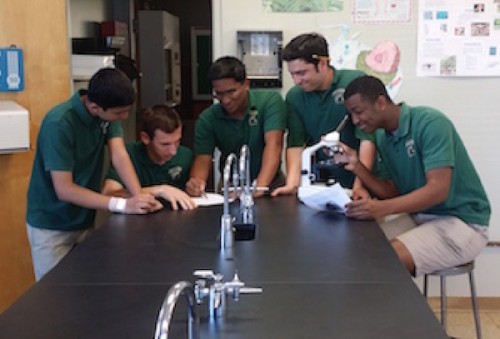
Garrett Souza, David Washington, Ashwin Balaji, Richard Conti, and Aaditya Patel examining a sample of tardigrades to ensure that the specimen is exhibiting normal locomotive functions.
Proposal Summary:
Tardigrades are extremophilic microorganisms, able to inhabit nearly all terrestrial environments by adapting to seemingly inhospitable circumstances. Through a process known as cryptobiosis, tardigrades virtually stop all metabolic processes when introduced to conditions such as extreme temperature, pressure, dehydration, oxygen depletion, or high energy radiation. Tardigrades can survive for years in this ametabolic state, resuming activity once reintroduced to a normal environment. Previous experiments have demonstrated that tardigrades are able to survive the rigors of space using this incredible evolutionary strategy. The proposed experiment is designed to expand upon these results by analyzing if both initially active and ametabolic tardigrades are able to survive six weeks of exposure to microgravity using cryptobiotic strategies.
The proposed experiment could significantly impact the future of space exploration, while also offering insight into the possibility of an extraterrestrial origin to life on Earth. If a large percentage of tardigrades are able to remain viable after exposure to microgravity, the results of this experiment would invoke further questions regarding the possibility of adapting tardigrades’ cryptobiotic mechanisms for human use. This would allow scientists to travel deeper into space over longer durations by inducing reversible ametabolic states. Furthermore, the ability of tardigrades to adapt to such hostile conditions suggests that they evolved in an unstable environment. If the results of the proposed experiment show that a large percentage of tardigrades remain viable after exposure to microgravity, it is possible that tardigrades originated from an extraterrestrial environment and arrived on Earth via asteroid or space debris.
HONORABLE MENTION FINALISTS:
The Effect of Microgravity on the Resistance of a Crystal
Grades 9-11, Damien High School, Los Angeles Archdiocese
Co-Principal Investigators: Carl Shen, Joshua Li, Simon Fei
Co-Investigator: Li Lao
Teacher Facilitator: Mr. Cusimano
Proposal Summary:
In our experiment, we will investigate how a substance’s electrical resistance changes when it reforms a perfect crystal structure under microgravity conditions. To be specific, we will analyze the crystal of CaCl2. Nowadays, ionic compounds are common substances that do not conduct electricity at room temperature in the lab. The crystal form of CaCl2, CaCl2•6H2O, is one of the most common and relatively heavy ionic compounds, which had a relatively big molar mass. We hypothesize if the ionic compound can be formed in a relatively perfect crystal structure under microgravity conditions, it would be different compared to its regular crystal formed under normal gravity conditions due to the crystal’s special form and its relatively small intermolecular forces. The difference may allow the conduction of electricity. It will help us to understand the property of the ionic bonded substance and electrolytes. In our experiment, we will create two CaCl2 crystals with the same process on the Earth and on the space station by common ion effect, which is a chemical theorem. We would put the sample on a special holder and test the resistance with the multimeter. The resultant data will be plotted as a coordinate graph showing the difference between the resistances of the CaCl2 formed on Earth and in microgravity, with varied temperatures in the lab during the analysis.
Human Insulin Production by Transgenic Escherichia Coli in Microgravity
Grade 11, Damien High School, Los Angeles Archdiocese
Co-Principal Investigators: Nickolas Hibshman, Juihung Sun
Co-Investigators: Adam Aurioles, Ram Reddy
Teacher Facilitator: Lisa LeDuc
Proposal Summary:
Genetic engineering via recombinant DNA is a promising technology by which a wide variety of proteins and biological products such as human insulin may be produced by simple prokaryotes, such as the bacterium Escherichia coli, that have been transformed. We wonder if such products may be manufactured similarly in space – a potential benefit to future efforts to inhabit space for long periods of time. By sending transgenic E. coli with recombinant plasmids in space, we hope to test the ability of prokaryotes to express recombinant genes for one of these products, human insulin, in a microgravity environment. Freeze-dried E. coli with a recombinant plasmid for human insulin will be activated by Luria broth media while in microgravity. The bacteria will transcribe the recombinant gene to produce insulin. Then cellular activity and growth of the bacteria will be inhibited by the addition of an antibiotic to prevent further insulin production while the experiment returns to Earth. Upon return, we will analyze the sample for the presence of insulin and compare total insulin yield to a control experiment conducted concurrently on Earth to note any major disparities that may be caused by the influence of lack there of of gravity.
2. Petaluma, California
Jump to Petaluma’s Community Profile
SELECTED FOR FLIGHT:
At What Rate will Algae Reproduce in a Micro Gravitational Setting Versus on Earth?
Grade 12, Petaluma High School, Petaluma City School District
Co-Principal Investigators: Morgan Giraud, Tara Thomas
Collaborators: Lulabel Seitz, Shelby Metten, Alana Roberts, Liza Strong
Teacher Facilitator: Victor Brazil and Linda Judah
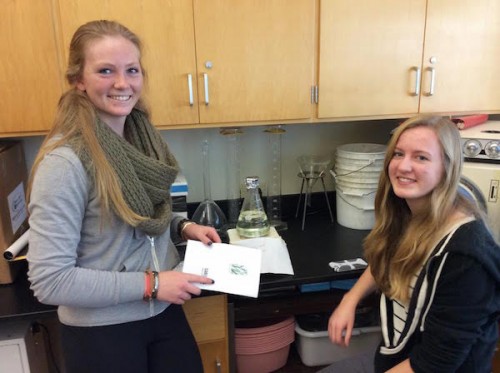
Petaluma High School students Morgan Giraud (left) and Tara Thomas (right) culturing algae for their experiment.
Proposal Summary:
Microalgal biomass can be used to produce bio fuel, animal feed and even dietary supplements for human consumption. Microalgae produces an average of 5000-15000 gallons of oil per acre per year, almost seven times more productive than the next productive oilseed yield (oil palm). Previously tested algae samples have shown that certain green algae can produce up to 77% oil content (Schiochytrium). However, because light is not available in the payload box on the International Space Station, for the microalgal biomass sample a heterotrophic strain of algae that can reproduce in the absence of sunlight was chosen. Scenedesmus is an algae used in biofuel production that is known to be durable and have around a 40% lipid content. This strain can also survive solely on glucose in order to reproduce. This investigation proposes to answer the question: At what rate will algae reproduce in a micro gravitational setting versus on Earth? The study is looking for changes in biomass produced in a given period of time in space compared to the number of cells reproduced on Earth in a lab setting. This experiment can later be applied to determine the amount of extractable oil yielded from algae samples, and other realistic applications for industrial, cosmetic, and supplement use. With the increasing concern for scarcity of non-renewable resources, the main intention is to provide a stepping-stone for future research. It is important to study different settings in which algae can grow in order to take advantage of the setting with the highest reproduction rate and highest efficiency. If it is determined that algae reproduce faster in a micro gravitational setting, then it may be beneficial to continue microalgal biomass cultivation in space as opposed to on Earth.
HONORABLE MENTION FINALISTS:
Frog Development in Space
Grade 9, Petaluma High School, Petaluma City School District
Co-Principal Investigators: Sara D’Ambrogia, Sallie Hollingshead
Teacher Facilitator: Linda Judah
Proposal Summary:
We want to find out how microgravity will affect the growth and development of frog eggs. For our experiment we will be using a Type 3 FME Mini Lab. In one chamber we will have unfertilized frog eggs. In the middle chamber we will have frog sperm. In the final chamber we will have preservatives. When the experiment gets up to the ISS, the clamp that is in between the frog eggs and the sperm will be taken off. Then the eggs will be fertilized. After a certain number of weeks, the clamp in between the preservatives and the rest of the chamber will be taken off. This will preserve the eggs or the tadpoles. At the same time down on Earth we will also release the preservative in our experiment. When the preserved eggs/tadpoles get back down to Earth we will compare the developmental differences between the experiment that was conducted in space and the experiment conducted on Earth. Finally, we will make our conclusion on how the frogs developed, and how microgravity affected the frogs’ development.
Solubility of Sugar in Microgravity
Grade 9, Petaluma High School, Petaluma City School District
Co-Principal Investigators: Whitney Royall, Lulabel Seitz
Teacher Facilitator: Linda Judah
Proposal Summary:
Our experiment involves testing the effects of microgravity on solubility. Sugar will be mixed with water, then the water will be filtered out; we can then see how solubility is different in microgravity through the amount of undissolved sugar crystals still present. There are multiple reasons as to why the information that will be found is substantial. First of all, the basic principle of solubility that is being tested is if the energy used to break hydrogen bonds in water (during the dissolving process) has the same force in a microgravity environment as it has on Earth. The experiment will also test if intermolecular bonds can still form well in a microgravity environment. There are scientific applications for the finding of this information, such as the contributions to the understanding of substance characteristics (because solubility is one of the characteristic properties of a substance). There are as well practical applications – such as how mixtures can be combined and separated via solubility principles and how they react differently to each other in microgravity, which will be important knowledge for astronauts. Besides, solubility as a general scientific principle has countless other practical applications, including many that are important to life, such as certain medicine uses. Besides the scientific information that this experiment can bring, it will also provide information that has practical applications that could help astronauts in space.
3. Santa Monica, California
Jump to Santa Monica’s Community Profile
SELECTED FOR FLIGHT:
The Effect of Microgravity on Paper Chromatography
Grade 8, Lincoln Middle School, Santa Monica/Malibu Unified School District
Co-Principal Investigators:Samuel Buckley-Bonanno, Adam Chamas, Charlie Gooding, Shrayes Raman
Teacher Facilitator: Carol Wrabel and Susan Stivers
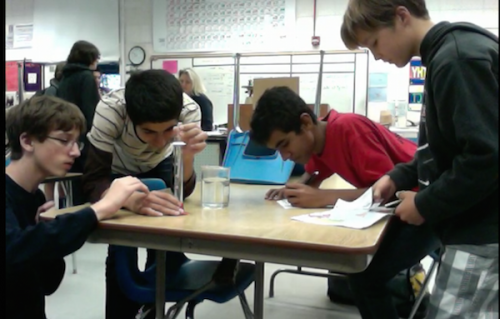
Charlie Gooding, Shrayes Raman, Samuel Buckley-Bonanno and Adam Chamas finding the correct volume of solvent to perform paper chromatography in an FME.
Proposal Summary:
The investigation proposes to determine whether chromatography can be performed in microgravity, and to discover how it may differ from being performed on Earth. Chromatography is a method by which you separate substances, using the capillary action of a solvent through a permeable medium. Paper chromatography was chosen because of it’s simplicity, and ease of use. For the experiment 3 ml of distilled water, 10 cm of coffee filter paper, and Papermate PMOP felt tipped pen ink will be used. A Type 3 MixStik was chosen, as it has the necessary capabilities in which the relatively complex experiment can be done. In Volume 1 there will be 3 ml of Water. In Volume 2, 10 cm of coffee filter paper, and in Volume 3, the ink dot and the rest (9 cm) of the coffee filter paper. When the experiment returns to Earth, how far, and in what ways the ink and water have traveled through the paper will be measured. This data will be compared with the controlled experiment on Earth. The knowledge gained from this analysis will provide a better understanding of chromatography, and various other aspects of physical chemistry, like capillary action. In the long run, this information can aid in the design of chromatography setups, whether on Earth or in microgravity. Additionally, any enclosure that permits capillary action, or molecular actions of a solute, can be designed in a better way, using the knowledge gained.
HONORABLE MENTION FINALISTS:
The Effect of Microgravity on the Degradation of Teeth by Coca-Cola
Grade 8, Lincoln Middle School, Santa Monica/Malibu Unified School District
Co-Principal Investigators: Natalie Bay, Sheena Sandhu
Co-Investigators: Jillian Axel, Hazelle-June Withers
Teacher Facilitator: Carol Wrabel and Susan Stivers
Proposal Summary:
Our experiment is to study the effect of microgravity on the degradation of teeth by Coca-Cola. We are conducting this experiment to determine if drinking Coca-Cola in space adversely affects your teeth like it does on Earth. Since bone density is a huge problem in space, this experiment is important to see how skeletal bone degrades in microgravity. We are planning to put a deciduous human molar tooth with a mass of 0.5 grams on the right side of the Type two FME. Then, we are going to clamp it and place 6.9 milliliters of Coca-Cola on the other side. If we can find what happens to teeth in microgravity, we can start to find out how other skeletal bones degrade since they’re linked together. The purpose of this experiment is not only to test whether or not Coca-Cola can degrade teeth, but to see how acids affect other tissues as well as other materials such as metals that are historically used for structures. We hope that this small experiment may lead to more profound discoveries about corrosion in the future.
The Effects of Microgravity has on the Reproduction Rate of E. Coli
Grade 8, Lincoln Middle School, Santa Monica/Malibu Unified School District
Principal Investigator: Benjamin M. Capehart
Co-Investigators: Oliver Mead, Dylan McCann, Eric Ton, Alex Weng
Collaborator: Leejoe Palickal
Teacher Facilitator: Gretchen Gies-Mclaughlin and Marianna O’Brien
Proposal Summary:
Escherichia Coli or E. Coli is a very standard bacteria used in many lab situations because it can be easily manipulated or observed under various conditions. E. Coli was discovered in 1885 by German Bacteriologist Theodor Escherichia in a human colon. E. Coli has been known to cause gastroenteritis and other related problems. Our group of students would like to observe how the reproduction rate (cells per minute) of E. Coli is affected in microgravity. We plan to send up 0.5 milliliters of dormant E. Coli cells stored in LB agar along with 2.0 milliliters of LB (Luria Bertani), Miller broth, and 2.8 milliliters of Formalin fixative (used to preserve E. Coli for observation) in a type three FME. After the experiment is conducted in space, and the E. Coli sample is returned to us, we will measure the amount of E. Coli bacteria present in the sample and use this data with the time the E. Coli was exposed to the growth medium to deduce how fast the E. Coli reproduces in microgravity setting. We will then compare it to the results of the same experiment conducted here on Earth. If an astronaut aboard the ISS were to contract a gastronomical related sickness due to E. Coli it would be of the essence to have knowledge as to how E. Coli reacts and reproduces in microgravity so proper treatment could be issued to said sick personnel.
4. Littleton, Colorado
Jump to Littleton’s Community Profile
SELECTED FOR FLIGHT:
Ladybugs in Space
Grade 5, Mount Carbon Elementary School, Jefferson County Public Schools
Co-Principal Investigators: Kylie Dappen, Maddison Gargiulo, Meghan Simpson
Teacher Facilitator: Pamela Laidley
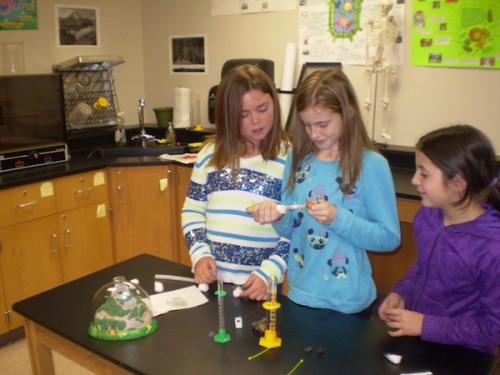
Dakota Ridge Articulation Area student researchers from Mt. Carbon assemble their Ladybugs in Space SSEP experiment.
Proposal Summary:
Ladybugs are a breed of beetle and can be identified by their red domed shell with black spots. These beneficial insects are a must-have for organic gardening or farming as they eat insects and pests that are destructive to the garden. Ladybugs primarily eat aphids, insects that suck the sap out of plants. An infestation of aphids can destroy whole gardens and decimate crops. A single ladybug can eat up to 5,000 aphids, which means they’re invaluable to farmers trying to control an aphid population without the use of harsh chemicals. At the present time experiments are being done in space to learn how to best grow food for possible colonization on Mars or future suitable planets. The ladybug may be helpful to control pests in space gardens. This investigation will study if the lifecycle of a ladybug is affected by microgravity. Dormant ladybug eggs, food, and other resources for growing and sustaining the ladybugs will be sent to the ISS (i.e., cotton ball saturated with water, rose leaf, raisins, and honey). Upon return to Earth, the current stages of the microgravity ladybugs will be compared against the current stages of the control group ladybugs to determine any differences in their growth.
HONORABLE MENTION FINALISTS:
The Effects of Microgravity on the Germination of Brassica oleracea (acephala group) Kale Seeds
Grade 5, Powderhorn Elementary School, Jefferson County Public Schools
Co-Principal Investigators: Blake Kinney, Antonio Ortiz
Teacher Facilitator: William Schmidt
Proposal Summary:
Astronauts need to have a fresh food source that is not only healthy, but able to grow in a microgravity environment. Our group believes that Brassica oleracea (acephala group) kale would be an excellent choice. Kale is a good source of calcium, vitamins and minerals that will help the astronaut’s bone density problem in space. Kale can grow successfully with as little as 3 hours of sunlight, does well in cooler temperatures, and has shorter roots which are preferable in space. Kale grows fairly quickly and only takes 20-30 days to become baby greens. Kale can tolerate a wide variety of soils and is drought tolerant. Scientists believe the water and soil on Mars are acidic and kale does better in a slightly acidic environment. Kale is considered a low maintenance, easy to grow plant. The purpose of our experiment is to see if kale will germinate in microgravity and what the effects will be. Our group will have a control experiment on Earth to which we can compare our results. The results could contribute to a healthy food source in space, as well as contribute to strengthening astronauts’ bones. Our hypothesis is both the space and Earth seeds will germinate, however, our group believes the seeds on Earth will grow faster and longer. Our belief is the seeds on Earth will grow towards the sun, while the space seeds will grow curved. Our group will also observe if the microgravity kale has the same nutrients and taste as the Earth kale.
Microgravity Effects on Crystal Growth
Grade 6, Mount Carbon Elementary School, Jefferson County Public Schools
Co-Principal Investigators: Faith Dunmyer, Greta Gurdikian, Nicole Oma
Co-Investigators: Kimberly Dunmyer, Tina Gurdikian, Nuria Perini
Collaborators: Joe Dunmyer, Bob Gurdikian, Eduardo Perini
Teacher Facilitator: Pamela Laidley
Proposal Summary:
We have one primary question: will microgravity affect crystal growth in space? Two secondary questions are: will the Borax and water even mix in microgravity, and assuming the Borax and water mix, will microgravity affect how crystals form in space? We will be conducting the exact same experiment concurrently on Earth, and will compare the two ending results. Assuming crystals grow in microgravity, we will examine both experiments (the one conducted at the International Space Station and the one conducted on Earth) for any differences in: where crystals form (on the tube itself and/or on the pipe cleaner), crystal shape, crystal size, and crystal color. Given the many uses of Borax on Earth, studying the effect of microgravity on Borax crystal growth will enhance our understanding for future applications of Borax use in space. For example, should we find that Borax crystals grow larger in space than on Earth, then potentially the flame retardancy of Borax will be magnified.
5. Hartford, Connecticut
Jump to Hartford’s Community Profile
SELECTED FOR FLIGHT:
How Does Microgravity Affect the Production of Synthetic Insulin?
Grade 8, Annie Fisher STEM Magnet School, Hartford Public Schools
Co-Principal Investigators:Alec Bulkovitch, Quishana Gillett, Nina Hall, Anxhela Mete
Teacher Facilitator: Keith Sevigny
Proposal Summary:
The investigation will study how microgravity affects genetically modified yeast’s ability to produce insulin. Saccharomyces cerevisiae is a type of yeast that when genetically modified, can produce synthetic insulin. (Ostergaard, Olsson, and Nielsen 2014) This insulin helps save a countless number of lives each year, more specifically people diagnosed with Type I and II diabetes. The investigation will include sending a sample of Saccharomyces cerevisiae to the ISS, have it produce synthetic insulin, and upon return compare it to how much insulin another sample of the yeast produces here on Earth. The hypothesis is that Saccharomyces cerevisiae will produce significantly more synthetic insulin on board the ISS because the genetically modified yeast may find it easier to yield the same amount of insulin than it would normally in Earth’s gravity. If it is found that there is no change or that there is a significant increase in the production of synthetic insulin, then the possibility of long-term space travel could be open to diabetics.
HONORABLE MENTION FINALISTS:
Does Microgravity have an Effect on the Muscle Systems of C. elegans When They are Given the Supplement Creatine?
Grade 7, Annie Fisher STEM Magnet School, Hartford Public Schools
Co-Principal Investigators: Trezure Hansley, Shanice Hutchinson, Claressa Maheu
Advisor: Tim Chehanske, University of Hartford
Teacher Facilitator: Keith Sevigny
Proposal Summary:
We would like to conduct an investigation in a microgravity environment to answer the following question; Would the use of Creatine help prevent loss of muscle mass in space? Caenorhabditis elegans (C. elegans) have already flown in space and have been proven they can survive the journey to the ISS with only one food source. Prior research of C. elegans have shown that C. elegans “appear to have strong similarities in human beings suggest that not only will prove an invaluable model for understanding the fundamental biological changes seen during spaceflight but that it may also be invaluable for understanding those changes associated with human health concerns in space.” (Adenle et al., 2009) If C. elegans can gain muscle mass in microgravity environment with the use of the body building supplement Creatine, maybe this could help astronauts maintain their muscle mass on long term missions. As part of our experiment, we will have dormant C. elegans on Agar cubes in their dauer larva stage. In order to wake them up, Astronauts will mix C. elegans with Escherichia coli (E. coli) strain OP-50 with Creatine as the food source. At the end of 3 days, astronauts will unclamp releasing the formaldehyde solution which will preserve the C. elegans. We would use a muscle-specific GFP marker, a strain that produces a GFP-myosin fusion protein that is expressed in muscle cells. By comparing results of our control to our space experiment, we hope to observe a difference in muscle growth in microgravity with the use of Creatine.
How Does Microgravity Affect the Bioluminescence of E. Coli Genetically Modified with GFP?
Grade 8, Annie Fisher STEM Magnet School, Hartford Public Schools
Co-Principal Investigators: Jewel Kerr, Vishaka Ravichandran, Janvi Sikand, Megha Tirumali
Teacher Facilitator: Keith Sevigny
Proposal Summary:
Our experiment will tell us if there is a difference in how much a group of E. coli expressing Green Fluorescent Protein glows when grown on Earth vs. in space. Our research has told us that Green Fluorescent Protein (GFP) glows when exposed to blue or ultraviolet light, and was originally obtained from the jellyfish Aequorea victoria. This protein has been inserted into the DNA of several laboratory organisms including various plants, bacteria, and animals such as rabbits, fish, and even monkeys so they express that gene. We have also found that bacteria such as E. coli that have been modified to have this feature can still glow after they have been killed; the GFP keeps on working since it is dependent on external stimulus. We predict that microgravity will not have an effect on the amount that the protein is expressed in E. coli that has been genetically modified with GFP. Microgravity has not been shown to directly cause DNA mutations in astronauts that go up into space, and we do not believe it would for a bacterium, either. We will test this prediction by conducting an experiment that allows GFP-modified E. coli to grow, then will preserve it with 4% formaldehyde. We will do this both on Earth and in space to compare them. Finding the answer to our question is important because if there is a difference, then we may be able to consider or rule out bioluminescence as a viable light source in space.
6. Bear, Delaware
Jump to Bear’s Community Profile
SELECTED FOR FLIGHT:
A Comparative Study of the Effects of Microgravity on Drosophila Melanogaster
Grades 9-10, Caravel Academy
Co-Principal Investigators:Kaelyn Connors, Lasya Katta, Ryan Lapointe, Kathryn North, Kelly Pyle
Teacher Facilitator: Meredith Swartzendruber
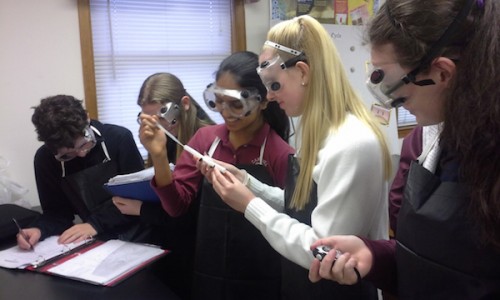
A team of 9th/10th grade student researchers practice protocols for prepping the FME mini-lab for spaceflight.
Proposal Summary:
This experiment will test not only how microgravity affects an organism’s body, but also how an organism born and grown in a microgravity environment would survive in Earth’s gravity. The investigation will study Drosophila Melanogaster (the common fruit fly) larvae because of their ability to become dormant in cold temperatures, common usage in biological experiments, resemblance to the human body structure, and small size. The larvae will remain dormant (refrigerated) until arrival at ISS. After arrival, the fruit flies will be exposed to the warmer temperature inside the ISS and will exit reproductive dormancy and begin to grow and reproduce. After several weeks, crewmembers will deactivate the experiment by closing one clamp to divide the flies into two populations, and then opening another clamp to introduce a fixative, permethirn-formaldehyde, to one of the populations. Upon return to Earth, the new organisms born in space will be compared to a control group that has been growing in Earth’s environment and gravity. From the data collected, the co-Investigators will analyze how microgravity affected the fruit flies and if the fruit flies (that were born in microgravity) are able to survive on Earth.
HONORABLE MENTION FINALISTS:
Growth of Survival of Algae in a Microgravity Environment
Grade 9, Caravel Academy
Co-Principal Investigators: Katie Capristo, Tyler Croce, Connor Emmons, Noah Schwartz, Shannon Swift
Teacher Facilitator: Meredith Swartzendruber
Proposal Summary:
The object of the following simple experiment is to determine if algal growth is possible in a micro-gravitational environment. A Type 3 FME will be used for this experiment, as well as green algal spores, water, and Lugol’s solution (iodine). By activating algae spores in water aboard the International Space Station, algae can grow in the space atmosphere while the same experiment is conducted on Earth at the same time. Once the algae at the ISS is about to journey back to Earth, it will be stopped by a fixative of Lugol’s solution to preserve the growth to compare it to the control experiment on Earth. With the information gathered by this experiment, many advances can be made no matter the outcome. If the algae is able to grow in space, it can be determined that simple life forms can exist outside of Earth’s atmosphere with the right nutrients provided to survive. If the algae does not grow to the same mass as the controlled experiment, the information can be used to stop harmful algae from growing in bodies of water and can eventually stop the spread of the more harmful parts of the species.
MSG Decomposition of a Nerve Cell and Myelin in Microgravity
Grades 10-11, Caravel Academy
Co-Principal Investigators: Madison Bolander, Jasnoor Hundal
Teacher Facilitator: Meredith Swartzendruber
Proposal Summary:
The focus of this experiment is to observe how microgravity affects the decomposition of a nerve cell, specifically the myelin surrounding it, using MSG. In this experiment, a nerve cell from a frog will represent that of a human and it will be combined with the crystalline form of the neurotransmitter glutamate, MSG (monosodium glutamate). In humans, an excess in Glutamate is believed to cause the disease Amyotrophic Lateral Sclerosis or ALS. In ALS the excess glutamate overstimulates nerve cells and actually kills them. In this experiment, we will observe if the crystalline form of Glutamate, MSG, has the same effects on the nerve cell as the glutamate produced in the human body. We will also observe if these results are different in microgravity than those produced on earth.
7. Camden, Delaware
Jump to Camden’s Community Profile
SELECTED FOR FLIGHT:
Breakdown of Hydrogen Peroxide in Microgravity
Grades 9 and 11-12, Caesar Rodney High School, Caesar Rodney School District
Co-Principal Investigators: Miranda Hunt, Dhruv Kumar, Clay Radford, Kyra Watson
Co-Investigators: Aysia Eskridge, Florin Fuad, Cade Lambert, Joshua Leczner, Kyle Maier, William Mosher, Alexis Webb
Teacher Facilitator: David Moore
Proposal Summary:
Our experiment tests the effects of microgravity on a chemical reaction. On earth, the gravity acts as a force pulling the reactants together in a test tube, while in space, there is no gravity pulling the reactants together, taking longer for reactions to occur. The chemical reaction we are testing is the decomposition of hydrogen peroxide (1.5 %H2O2) as the enzyme catalase breaks it down. We believe that if there is no microgravity effecting the reaction, the catalase will not break down the hydrogen peroxide (H2O2) as much as it would on Earth with the effects of microgravity. After a short time, giving the reaction time to occur, a 10 % H2SO4 solution dissolved in distilled water will be added to the solution so that the reaction between catalase and hydrogen peroxide will be stopped so the decomposition can be measured. Back on Earth, the amount of hydrogen peroxide that decomposed will be measured through a titration procedure with potassium permanganate (KMnO4). The results of the experiment will be compared to a control experiment conducted on Earth with the same procedures. Therefore, we will be able to observe the effects of microgravity on an enzymatic chemical reaction.
HONORABLE MENTION FINALISTS:
The Effect of Microgravity on the Rate of Cellular Respiration of Non-Germinating Peas
Grades 11-12, Caesar Rodney High School, Caesar Rodney School District
Principal Investigator: Channah Mills
Co-Investigators: Emily Booth, Brittany Burris, Mindy Cook, Rebekah Mills
Teacher Facilitator: David Moore
Proposal Summary:
This experiment is intended to measure the rate of cellular respiration in microgravity. We will be testing the amount of oxygen (O2) used by non-germinating peas in order to determine the rate of cellular respiration. The experiment will determine if the different pressure resulting from the microgravity will alter the amount of O2 measured as a result of the experiment compared to the amount tested on Earth. This will allow future space-goers to know how much oxygen is required for both themselves and the experiments they are conducting with various oxygen-requiring organisms. If microgravity changes the rate of cellular respiration, different amounts of oxygen will need to be provided to those organisms.
The Effects of Microgravity on the Growth of E. coli Bacteria
Grades 10-11, Caesar Rodney High School, Caesar Rodney School District
Co-Principal Investigators: Eric Jones, Brianna Smith, Correy Washburn
Co-Investigators: Dominique Richardson, Courtney Sarlouis, Jeremy Voshell
Collaborator: Payton Smith
Teacher Facilitator: David Moore
Proposal Summary:
The question our group will be attempting to discover with our project is what will happen to bacterial growth in microgravity; how will the shape of the colonies change? We believe that E. coli will grow at a faster rate but not grow as large while in microgravity. Microgravity is appropriate for this experiment because of the near weightlessness nature, this will allow the bacteria to grow faster thus providing us with more data for our research when the experiment returns to Earth. The current understanding is that microgravity speeds up the process of bacteria growth. What we hope to learn from this experiment is the effect that microgravity will have on E. coli colony shape.
8. Hillsborough County, Florida
Jump to Hillsborough County’s Community Profile
SELECTED FOR FLIGHT:
Operation Germination of Cottonseeds
Grade 5, FishHawk Creek Elementary School, Hillsborough County Public Schools
Co-Principal Investigators: Karinna Crespo, Chandrika Ganduri, Casey Utsler
Teacher Facilitator: Mary Vaughan
Proposal Summary:
The investigation will study if microgravity affects the frequency rate of the germination of cottonseeds. Cottonseeds were chosen because research indicates that the seeds can germinate on the space station. The germination of cottonseeds would allow for scientists to learn more of the germination of seeds in microgravity. Cottonseed oil could also be used by humans for many reasons such as food additives, for skin care, and medicinal reasons. This could be beneficial for longer space missions. In volume 1 of the MixStix will be seven cottonseeds wrapped in felt. In volume 2 5 mL of tap water from FishHawk Creek Elementary School, and in volume 3 seven additional seeds wrapped in felt. Dr. Gioia Massa, the Principal Investigator of Veggie 01 and research on other previous experiments indicated that felt is a good medium for germinating seeds. Cottonseeds require close contact with the material they are germinated in and tightly wrapping the seeds assists with encouraging germination. A cold pack will be used for return shipping when the MixStix is returned to Earth. In microgravity, the early cottonseeds will be activated 2 days after arrival on the space station and the second set of seeds will be activated 14 days before returning to Earth. Cottonseeds have a germination rate of 7-14 days.
HONORABLE MENTION FINALISTS:
Chemistry in Space
Grade 5, FishHawk Creek Elementary School, Hillsborough County Public Schools
Co-Principal Investigators: Cody Basquill, Aidan Husbands, Tosimi Loye, Nick McNally
Teacher Facilitator: Mary Vaughan
Proposal Summary:
Our future in space is progressing fast. Soon, we will be conducting complex experiments and investigations in microgravity, including chemistry. When we start with chemistry in space, one of the categories will be medicine. Sodium Chloride (NaCl) and Silver Nitrate (AgNo3) will, in fact be components in medicine. However, handling these chemicals, especially together, can be extremely dangerous. If the two leaked and got into an essential console, the space craft or the International Space Station could be in danger. Here on Earth, the two chemicals precipitate or create a different substance when mixed. If the precipitation process happens within a machine, it could jeopardize the lives of many people. The results of our experiment could prevent an accident. One must know that the two do precipitate or not. That is why we are conducting the experiment “Chemistry in Space.” The question we will be conducting is will sodium chloride and silver nitrate precipitate in microgravity versus on Earth. Our scientific progress in space is growing quickly, and astronauts will be conducting more complicated experiment in space related to chemistry. Sodium chloride and silver nitrate are both chemical compounds that are both used in medicines. However, down here on Earth, they do precipitate. How to Make Silver Nitrate: First, add a bar of pure silver to a vat of nitric acid. Gently burn the vat until it starts to bubble. Then, wait until the silver is completely dissolved. Let the solution stay in one location and AGN02 crystals are formed.
Mixing It Up In Space
Grade 5, Roland Park K-8 Magnet School, Hillsborough County Public Schools
Co-Principal Investigators: Bradley Evans, Varsha Kotamreddy
Teacher Facilitator: Adrienne Rundle
Proposal Summary:
Astronauts in a microgravity environment can lose bone density at a rate of about 1% a month, so it is important for astronauts to have food that is high in protein and calcium to help slow down the rate of bone loss. Since soybeans are a great source of protein and calcium scientists have been working hard for quite some time to include soybeans into an astronaut’s diet. Soybeans are now able to be grown in a microgravity environment, so the astronauts on the International Space Station (ISS) have access to soybeans. Our plan is to send ground soy beans, distilled water, and premixed soy milk to find out how well soy milk can be mixed in microgravity. We chose soy milk and not mammalian milk because soy milk contains a higher content of protein and calcium and these are critical to maintain bone density. This experiment is looking at how well crushed soybeans (soy pulp) will mix with distilled water to make soy milk. If the soy milk made in space can be mixed, that will give the astronauts another way to supplement their diets with additional protein and calcium by drinking or adding to other food items. Our hypothesis is that they will not mix as well and stay mixed as long to make the soy milk in the microgravity environment, as it would on Earth.
9. Sioux City, Iowa
Jump to Sioux City’s Community Profile
SELECTED FOR FLIGHT:
Go Nuts in Space
Grade 9, North High School, Sioux City Community School District
Principal Investigator: Robert Hwang
Co-Investigators: Rachel Hodgins, Tammy Tran
Teacher Facilitator: Pam Malone-Mason
Proposal Summary:
The experiment is to conduct a commercially available peanut ELISA test on the International Space Station. It is speculated that astronauts’ immune systems are suppressed in microgravity condition, as the astronauts are more likely to develop infections in space. The experiment asks, “Would allergies, another type of immune response, be suppressed as well by the effect of microgravity?” Allergies affect quality of life and cost billions of dollars in medication and hospitalization. Peanut allergies, in particular, have been increasing in number and severity for several decades. Will a person with a documented peanut allergy still develop allergic reactions in space? An allergic person has an excess of a type of antibodies called Immunoglobulin E produced overtime, and these antibodies are bound to the mast cells of the immune system. In an allergic reaction, the antibodies bind with the allergens, and then the complex binds to a receptor on the mast cell, and causes the mast cells to release histamine. In the experiment, peanut-specific antibodies will be mixed with peanut protein in the MixStix. The same test will be conducted on Earth as a ground experiment. The results will be compared to see if antibody-peanut binding is suppressed, enhanced, or the same in space. The results of the study will reveal the impact of microgravity on allergic reactions, which will in turn, help us understand more about how allergies work and to find a cure to allergies on Earth.
HONORABLE MENTION FINALISTS:
Would Chia Seeds Sprout in Microgravity?
Grade 11, East High School, Sioux City Community Schools
Co-Principal Investigators: Jerry Bailey, Brianna Cook, Grace Hoefer
Teacher Facilitator: Trevor Miller
Proposal Summary:
Our experiment that we are proposing is whether or not chia seeds would sprout in microgravity. We intend to send up a test tube that holds chia seeds and water separately, and then when it reaches the ISS, let them go together. We are curious to see if the seeds could sprout in microgravity because they are good for multiple uses. If this experiment is successful, it could open a lot of doors for growing your own food at the International Space Station.
Separation of Human Blood
Grade 11, East High School, Sioux City Community Schools
Co-Principal Investigators: Catrina Branch, Brittany Nelson, Kilee Piklapp
Teacher Facilitator: Trevor Miller
Proposal Summary:
We would like to test the separation of human blood in microgravity. We know the separation requires gravity, but we would like to know how the speed of the separation would change. It could help us figure more out about the process the blood takes to separate. The speed might be different from Earth’s gravity compared to microgravity, and may separate into more or less parts.
10. Fitchburg, Massachusetts
Jump to Fitchburg’s Community Profile
SELECTED FOR FLIGHT:
How is the Growth of the Bacteria Rhizobium radiobacter Affected by Microgravity?
Grade 11, Montachusett Regional Vocational Technical High School, Montachusett Regional Vocational Technical School District
Co-Principal Investigators: Jezrielle Bruno, Marina Good
Teacher Facilitator: Paula deDiego
Proposal Summary:
The investigation will study how the growth of the bacteria, Rhizobium radiobacter, is affected by microgravity. R. radiobacter is a bacterium that causes “plant cancer”, also known as Crown Gall Disease. It has a portion of a T-DNA that inserts itself into the plant’s DNA. This causes the plant cell to alter and expand, forming a tumor, as a result of altered cell genomes. This experiment will provide an understanding of the effects, if any, microgravity has on the growth of R. radiobacter. It will investigate whether there is a change in growth rate of the bacteria, and whether the production of endotoxins is affected. Typically, the higher the level of endotoxins, the more bacterial growth there is. Therefore, this is an important factor that will be analyzed after the completion of this experiment. In order to address the concern of over-growth and eventual starvation and/or death of the bacteria, a substance known as acetosyringone, which has resulted in growth-inhibition and decreased virulence in specific strains of R. radiobacter has been included. In consideration of this factor, the C58 strain of bacteria was chosen for the experiment, as the acetosyringone has inhibited the growth of this particular strain of R. radiobacter.
HONORABLE MENTION FINALISTS:
How can Bifidobacteria Benefit Astronauts in Space?
Grade 11, Montachusett Regional Vocational Technical High School, Montachusett Regional Vocational Technical School District
Co-Principal Investigators: Jillian Duval, Hannah Moilanen
Collaborators: Dalton Brisbois, Taylor Sadowski, Carly Walsh
Teacher Facilitator: Paula deDiego
Proposal Summary:
The purpose of our experiment is to see the growth rate of Bifidobacterium while under the affects of microgravity. If it is able to produce and adequate amount of bacteria, we will be able to produce a probiotic available to the astronauts during their extended time in space. This probiotic will hopefully be able to help improve the weaken immune system due to the affects of space travel, and be able to treat common stomach ailments.
The Effects of Microgravity on Streptococcus mutans
Grade 10, Montachusett Regional Vocational Technical High School, Montachusett Regional Vocational Technical School District
Co-Principal Investigators: Olivia Houle, Shelby Landress
Collaborators: Autumn Kelly, Jennifer Gosselin, Madison Clark
Teacher Facilitator: Paula deDiego
Proposal Summary:
This experiment has the potential to be successful in finding a better dental care regimen for astronauts. The factor being observed in our experiment is whether or not Streptococcus mutans produce more lactic acid in microgravity and if the reproduction rate of the previously stated bacteria is affected in space. Improper oral hygiene is a factor of poor health in the rest of the body. If the Streptococcus mutans prove to be a greater force in space than they do on Earth, then the protocol for astronauts may need to be changed. Previous studies referenced in this proposal reinforce the hypothesis that dental caries are more likely to occur in space because of microgravity.
11. Duluth, Minnesota
Jump to Duluth’s Community Profile
SELECTED FOR FLIGHT:
The Detriment of Microgravity on Xenopus Laevis
Grade 12, Duluth Marshall High School, ISD 709
Co-Principal Investigators: Allison Hall, Anna Nordin, Pentti Hanlon
Teacher Facilitator: Paul Schonfeld
Proposal Summary:
The investigation will analyze the effects of microgravity on Xenopus laevis embryos. Previous NASA studies on Xenopus laevis in microgravity have investigated how to reduce oxidative damage and stress using glutathione. This investigation will focus solely on the negative effects of microgravity, so an antioxidant will not be added to reduce the oxidative stress, and the effects of microgravity will be analyzed. The hope is that by studying Xenopus laevis invaluable insights into the development of organisms in space will be gained.
HONORABLE MENTION FINALISTS:
The Effects of Microgravity on Fruit Fly Development
Grades 11-12, Duluth Marshall High School, ISD 709
Co-Principal Investigators: Clayton Gunnarson, Erik Shirley, McKayla Aanonsen, Rebecca Bilden
Teacher Facilitator: Paul Schonfeld
Proposal Summary:
Our proposal for the SSEP project is to study the development of fruit fly eggs in space. We are planning on sending up the tube with male and female flies that we will put together to make eggs. We will see what percentage of the eggs laid hatched and compare it to what happens on Earth. Fruit flies are ideal creatures for this experiment because they require such low maintenance. Originally, we expected to do something with cell division and how cells would be affected by microgravity. The idea originally stemmed from the idea of human embryos and how they develop, but we knew that wasn’t a plausible idea, so we moved onto something else: fruit flies. Originally, we wanted to see if the protein production was sped up in space with the introduction of E. coli, but after further research, we discovered that using E. coli was not realistic. After using E. coli proved too difficult, we decided to drop it and just use fruit flies. We’re hoping to be able to see positive and/or negative effects of microgravity on fruit fly egg development, which could maybe lead to ideas on human or larger animal eggs and embryos in space.
Tardigrades and the Effects of Anhydrobiosis in Microgravity
Grade 11, Duluth Marshall High School, ISD 709
Principal Investigator: Grace Maki
Teacher Facilitator: Paul Schonfeld
Proposal Summary:
My proposal focuses on the effects microgravity has on anhydrobiosis in tardigrades. Tardigrades are very small invertebrates known to survive extreme environmental conditions such as lack of water. They can do this by undergoing a type of cryptobiosis called anhydrobiosis. Cryptobiosis is a state in which metabolic activities come to a standstill. During anhydrobiosis, the animal enters an almost completely desiccated state which stabilizes its membranes and other cellular structures, preventing otherwise lethal damage caused by environmental extremes. I will send 2-5 live Tardigrada up in space in a test tube without water. To survive, they will undergo anhydrobiosis. I will be conducting the same ground experiment simultaneously. Upon return, I will use video analysis to capture the exact times of rehydration, as well as taking notes on eating habits and movements compared to the tardigrades in the ground experiment. In doing so, I will be able to come to a conclusion of the effects microgravity has on anhydrobiosis in tardigrades.
12. Brookhaven, Mississippi
Jump to Brookhaven’s Community Profile
SELECTED FOR FLIGHT:
Yeast as a Model Organism to Study COX-2 Enzyme Production in Microgravity
Grade 10, Brookhaven Academy
Co-Principal Investigators: Missy Noel Clanton, Mica Bailey Stewart
Teacher Facilitator: Leslie Hood
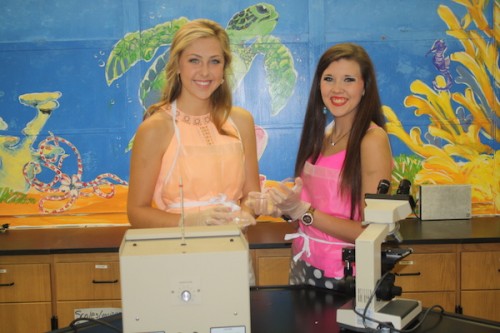
Missy Clanton (l) and Bailey Stewart (r) prepare to isolate a pure culture of the yeast Saccharomyces cerevisiae.
Proposal Summary:
Colorectal cancer (CRC) has affected many lives throughout the nation. Studies show that one in twenty people get CRC each year. This cancer is caused by uncontrolled cell growth in the colon, rectum, or appendix. Colorectal cancer is the second leading cause of cancer-related deaths in the United States. Statistics show that over 90% of people who get colorectal cancer die. Experiments show that the enzyme cyclooxygenase 2 (COX-2) is elevated in 85% of colorectal cancer patients. Aspirin has been shown to inhibit the production of COX-2 enzymes in human test studies. Overexpression of COX-2 results in inflammation and uncontrolled cell proliferation, which may lead to tumor formation. Apoptosis is a highly conserved pathway in eukaryotic organisms to promote programmed cell death (cell suicide) when cell damage can result in cancer. Yeast is often used as a model organism in cancer research. The yeast Saccharomyces cerevisiae is used in this study due to its production of the COX-2 enzyme and its suicidal response (apoptosis) to aspirin. Microarray analysis will be used to measure mRNA levels of several thousand genes in yeast, including those involved in the production of COX-2 and the initiation of programmed cell death. The specific aim of this investigation is to evaluate gene expression in S. cerevisiae by microarray analysis. Statistical analysis will determine possible variances in the Earth based experiment compared to microgravity.
HONORABLE MENTION FINALISTS:
The Effect of E. Coli to Manipulate Sodium Chloride Crystals in Microgravity
Grade 12, Brookhaven Academy
Co-Principal Investigators: Emily Allbritton, Luke Henry, Brantley Weeks
Teacher Facilitators: Dianne S. Watson, Leslie Hood
Proposal Summary:
Will the bacteria, Escherichia coli, maintain its ability to manipulate salt crystals in microgravity? E. coli is an aerobic, rod-shaped, gram-negative bacteria which helps the digestion processes, food breakdown and absorption, and vitamin K production. When E. coli is introduced to NaCl crystals, it undergoes self-assembly in conjugation with the NaCl that produces complex biosaline drying patterns on plastic surfaces. When the two substances are left to dry, the bacteria manipulates the NaCl crystallization to create biomineralogical biosaline 3-D morphologically complex formations, where they begin to hibernate. This experiment will determine whether E. coli can manipulate the sodium chloride crystals the same way in microgravity. Water is the most fundamental molecule on Earth, therefore; an important research topic for astrobiology is the search for hibernating life-forms in waterless environments. On November 12, 2014 after ten years and four billion miles, The European Space Agency’s Rosetta mission and its Philae lander made history. The lander made it to the surface of Comet67P/Churyumov- Gerasimenko. It has successfully sent many photographs and videos back to Earth. Research is being done every day because the comet is thought to hold material dating from the origin of the solar system, some 4.5 billion years ago. If the bacteria is able to manipulate the crystals in microgravity in the same manner that it does on Earth, there is a possibility that strains of E. coli exist in salt crystals on meteorites.
Efficacy of Clindamycin and Penicillin Against Streptococcus Pyogenes in Microgravity
Grade 11, Brookhaven Academy
Co-Principal Investigators: William King, Allison Livingston, Ben McCarroll
Teacher Facilitator: Leslie Hood
Proposal Summary:
Streptococcus pyogenes is a gram-positive bacterium that belongs to the Eubacteria kingdom. This bacterium is ubiquitous in nature and a common human pathogen. S. pyogenes is a highly infectious bacterium which causes; puerperal fever, scarlet fever, pharyngitis, impetigo, and cellulitis. Two major drugs are used to treat S. pyogenes. The bacteriostatic drug, clindamycin, belongs to the lincosamide class of antibiotics, and can be used for many health problems. Penicillin, a Blactam antibiotic, disrupts the cell wall of bacteria. Clindamycin has a greater efficacy on S. pyogenes than penicillin. Normally, these two do not have a synergistic effect when used together. Therefore, the question to be addressed is will microgravity increase the efficacy of clindamycin and penicillin against S. pyogenes? Flow cytometry and scanning electron microscopy (SEM) will quantify the differences in the Earth based sample versus the one exposed to microgravity.
13. Kansas City, Missouri/Kansas
Jump to Kansas City’s Community Profile
SELECTED FOR FLIGHT:
Will Sunflower Seeds Grow in Microgravity?
Grades 6-7, Crossroads Academy of Kansas City, ISD 709
Principal Investigator: Saul Rodriguez
Co-Investigators: Kevin Alvarez, Jorge Ortiz
Collaborators: Michyla Westbrook-Samuels, Nautica Wiggins
Teacher Facilitator: Kristen Marriott
Proposal Summary:
This investigation will study if sunflowers will germinate in microgravity. The hypothesis is that sunflower seeds will germinate in microgravity. The sunflower seeds will be provided purified water and potting soil. Onboard the ISS, crew members will open the clamp introducing the water to the soil and seeds, and shaking the MixStik to mix. Sunflower seeds were chosen because they are healthy, and can be a source of food. Upon return to Earth, the flight MixStik will be analyzed to see if the seeds have grown roots and begun germination.
HONORABLE MENTION FINALISTS:
Decomposition in Space
Grade 5, Academie Lafayette
Co-Principal Investigators: Ramona Eshleman, Skylar Mirador
Teacher Facilitator: Cathy Metcalf
Proposal Summary:
With astronauts living in space for longer periods of time and the desire to study distant planets, it will be necessary to grow food in space. One of the key factors in growing plants is nutrient-rich soil. Decomposition of natural elements is one way to produce nutrients for plant growth. In this experiment, we will assess the possibility of decomposing natural elements in microgravity in order to produce nutrients for plants. If it works, it will benefit mankind by allowing humans to stay in space for longer periods of time.
Antibiotics in Space
Grade 7, St. Peter’s School, Kansas City St. Joseph Diocese
Co-Principal Investigators: Zayin Barnes, Anna Johnson, Charlotte McKee, Caroline Smith
Teacher Facilitator: Robert J. Jacobsen
Proposal Summary:
The researchers will be conducting an experiment to determine the effect of penicillin [an antibiotic] on the streptococcus bacteria. The researchers will be conducting this experiment because they would like to determine if the effect of penicillin is the same in an environment of microgravity versus the environment of Earth and its gravity.
14. Johnson County, Nebraska
Jump to Johnson County’s Community Profile
SELECTED FOR FLIGHT:
Germinating Red Clover (Trifolium pratense L)
Grades 11-12, Johnson County Central High School, Johnson County Central Public Schools
Principal Investigator: Rudy Pooch
Co-Investigator: Isaac Buss
Collaborators: Keelee McClintock, Natalie Roddy, Mason Waring
Teacher Facilitator: Nichole Justesen
Proposal Summary:
If humans plan to establish permanent bases in space, they will need to be able to cultivate their own food. On Earth, legumes are used to fixate nitrogen into soil, making it fertile. In this experiment red clover seeds (Trifolium pratense L), cotton, potting soil, and water are used to examine how much nitrogen is produced. Upon return to JCC after its time onboard the ISS, the nitrogen levels of both the flight experiment and the control will be assessed using a soil testing kit. Both ground and space experiments will be planted in separate planter boxes and the nitrogen levels will continue to be tested throughout the plants’ entire life cycle. The hypothesis is that red clover will release about the same quantities of nitrates after germinating in space as they would after germination on Earth. This study could be a small step in creating a suitable environment in space to grow and harvest crops for future food with a bonus of medicinal purposes. Red clover seeds were chosen for the investigation because they are a legume commonly used by local farmers in Johnson County, NE in crop rotations to enrich the soil. Could this plant be the answer for fertile soil in space? Will the red clover fixate more or less nitrates into the soil? While many studies have dealt with seed germination, none of them have addressed the symbiotic relationship between a legume and Proteobacteria.
HONORABLE MENTION FINALISTS:
Growth of Artemia NYOS in Microgravity
Grades 10 and 12, Johnson County Central High School, Johnson County Central Public Schools
Co-Principal Investigators: Schyler DeFreece, Sara Kettelhake, Sophia Kongmanyvong, Courtney Klaasmeyer, Karina Martinez
Teacher Facilitator: Vicky Boone
Proposal Summary:
It was proposed that the experiment on the growth of Artemia NYOS, commonly called sea monkeys, be conducted. Our experiment includes growing and recording. Preliminary experiments were done to calculate how much the sea monkeys will grow in 6 weeks on Earth; then those results will be compared to the results received in microgravity. Many special precautions were made to make the results more reliable and precise. In addition, we now have the right proportion of all the materials that go into the test tube. The purpose of this experiment is to observe growth in space. The sea monkey experiment could give us insight on human growth in space. The sea monkeys do not tell us what will happen to humans but will give us an idea on what might happen. This is important due to the fact that someday humans are very likely to want to reproduce in microgravity.
The Effect of Microgravity on the Cellular Structure of Chlamydomonas reinhardtii
Grade 12, Johnson County Central High School, Johnson County Central Public Schools
Principal Investigator: Michael Purcell
Co-Investigator: Omar Arellano
Collaborators: Michael Clark, Lindsay Weber
Teacher Facilitator: Vicky Boone
Proposal Summary:
Space is the next frontier. Earth holds seven billion people today. This number keeps growing daily. By 2050 Earth will hold about nine billion people. As the Earth’s population keeps growing humans become prone to starvation and epidemics. If mankind wants to keep expanding then we will need to look to the stars. At this time humans have problems with living in space. Our bodies have many short-term side effects of microgravity. There are three long term side effects: bone loss, cellular organization, and radiation. We decided that we should experiment with the long-term side effects to build on our understanding of human life in space. As a way to study cellular organization in microgravity we chose to send the algae Chlamydomonas reinhardtii into space. Chlamydomonas reinhardtii is a versatile organism. These algae can survive with light as the sole energy source or entirely on an acetate food source. Using Chlamydomonas reinhardtii gives us the opportunity to send a genetically similar sample into space.
15. Pennsauken, New Jersey
Jump to Pennsauken’s Community Profile
SELECTED FOR FLIGHT:
Staphylococcus Epidermidis In Microgravity
Grade 8, Howard M. Phifer Middle School, Pennsauken Public Schools
Co-Principal Investigators: T’asiah Lawson, Thaliyyah Eason, Thomas Tran
Collaborators: Alex Little, Dazhane Brown
Teacher Facilitator: Amy Fisher
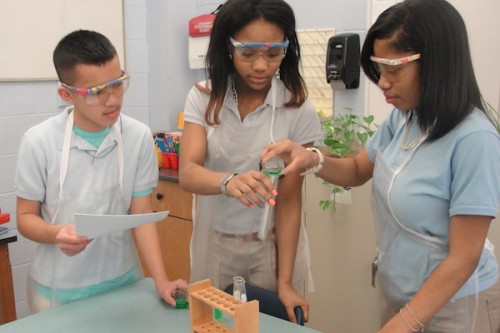
Mission 7 8th grade flight team in Pennsauken, NJ, will assess if there is a change in the natural antibiotic resistance in Staphylococcus Epidermidis, a close cousin to MRSA.
Proposal Summary:
Methicillin-resistant Staphylococcus aureus (MRSA) is a bacterium that is resistant to most antibiotics. This investigation is testing if there is a change in the natural antibiotic resistance in Staphylococcus Epidermidis (SE) in microgravity. SE, which is a close cousin to MRSA, is less contagious, and safer to handle. The hypothesis is that the bacteria has a weaker resistance against antibiotics in microgravity because the microgravity conditions on the ISS affect the bacteria negatively. The SE bacteria has to adapt to the new environment, allowing the antibiotics to work more effectively against the bacteria. MRSA has been sent up to the ISS to develop a potential vaccine for use on Earth. From this experiment we can learn more about SE as well as work towards developing a better cure for all types of Staph infections in space.
HONORABLE MENTION FINALISTS:
Microgravity and Lactobacillus
Grade 8, Howard M. Phifer Middle School, Pennsauken Public Schools
Co-Principal Investigators: Neishaliz Beltran, Keyla Estrada, Jasmyne Hinson
Collaborators: Brenden Connelly, Jada Gabri-El
Teacher Facilitator: Amy Fisher
Proposal Summary:
Our proposal is that we should test how well lactobacillus thrives in microgravity compared to on Earth. We think that the amount of time it takes to grow may differ in space, compared to on Earth, due to the lack of gravity. There is nothing we could find about this bacterium in microgravity, specifically, but we know it could greatly benefit the astronauts as a food source and something to increase their health. This topic interested us because lactobacillus is in many of the foods we eat, so we wanted to see if this bacteria would be able to grow in space. In addition, it is one of the most commonly used probiotics and we wondered if it would be of any use to the astronauts. We would like to know if lactobacillus could grow in different environment. This experiment could influence science because we could find new ways to use lactobacillus.
What Are the Effects of Microgravity on the Nutritional Value of the Albacore Tuna?
Grade 8, Howard M. Phifer Middle School, Pennsauken Public Schools
Co-Principal Investigators: Jasmine Edwards, Dairon Estevez, David Louie, Joshua Valente
Collaborators: Gabriel Myles, Tiann Hawkins
Teacher Facilitator: Amy Fisher
Proposal Summary:
Our proposal is to send 10 albacore tuna embryos into space to see if their nutritional value increases, stays the same, or decreases. In addition, we want to see if it’s still edible when sent into space. In the tube we want to have the embryos, a clamp, then water, a clamp, then food. We also want to see if their growth process and behavior is the same in space as on Earth. We want to see how long they can last and if some of them die or if all them make it. There are many variables that we have to consider when doing this experiment. We know that we cannot add anything to the tube or take stuff away. They can only unclamp so if something goes wrong they can’t do anything about it. We have considered and thought about things that could go wrong and make sure we are taking steps to prevent that. We know that albacore tuna is one of the healthiest fish and they grow at a rapid pace. Albacore tuna is found in the open tropical waters of all tropical and temperate oceans. We believe that this is important to study because it could advance our knowledge on how to live in space. Since people need to eat, this could really help humans grow a source of food in space. Not only this, but we need to stay healthy so it is also important to see if the fish retain their nutritional value. You can obtain albacore tuna eggs at a breeding farm.
16. Somerset, New Jersey
Jump to Somerset’s Community Profile
SELECTED FOR FLIGHT:
Evaporation Investigation
Grade 5, Thomas Edison Energy Smart Charter School, Franklin Township New Jersey
Co-Principal Investigators: Natalia Arevalo, Meghan Gajula, Kareena Kapadia
Teacher Facilitator: Maya Ghosh
Proposal Summary:
The investigation will study if water evaporates faster under microgravity or on Earth. If water evaporates faster in microgravity, then astronauts need to consume more water to keep them healthy but, if water evaporates slower, then astronauts need to consume less water. Water is in all living things, vegetation, and our body. In a regular environment, water constantly changes its state from liquid to gas. Fruits dry, and the body sweats all because water constantly evaporates. The investigation will simulate water evaporation. In volume 1 of the mini-lab will be placed some cotton containing a few drops of water, and some “silica gel”(tiny, solid micro-beads). The silica gel will absorb moisture from the air within the mini-lab, and force the water from the cotton to evaporate. The same investigation run on the ISS will be run on Earth. The difference in the weight of the cotton before and after the experiment will determine how much water evaporated in the mini-lab. The health of astronauts is heavily dependent on how fast or slow they sweat and how much water they have to drink to replenish fluids in their body. Similarly, astronauts may need to know how long foods will stay fresh to keep enough food if we were to colonize in outer space.
HONORABLE MENTION FINALISTS:
Advanced Food Production and Preservation in Microgravity Environment
Grade 6, Thomas Edison Energy Smart Charter School, Franklin Township New Jersey
Co-Principal Investigators: Anushri Prasad, Trisha Senthilkumar, Naimisha Vidavalapati
Advisors: Mrs. Ashwini, Dr. Mukund Kharwal, Prasad Konaka, Senthil Ramakrishnan, Manoj Vidavalapati
Teacher Facilitator: Maya Ghosh
Proposal Summary:
Our proposal is to help astronauts in the space station to protect their food through this experiment of protecting Lactobacillus bacterium thru the micro-encapsulation process. And the reason why we chose this experiment is because it has potential to bring multidimensional benefits to ISS and our astronaut community. It will help our astronauts to prepare and protect their own food as needed which is not only hygienic, but can also help prevent several diseases and improve the health of our astronauts during their mission. Also it will help to reduce the cost spent on food preservation at space, money savings that can be better used elsewhere. So, we firmly believe this process has a great future for astronauts and ISS.
The Effectiveness of Curcuma longa (Turmeric) Against Bacteria in Microgravity
Grade 4, Thomas Edison Energy Smart Charter School, Franklin Township New Jersey
Co-Principal Investigators: Raina Desai, Panav Gala, Jiya Patel
Advisors: Rashmi Naphade, Jeffra K. Schaefer
Teacher Facilitator: Maya Ghosh
Proposal Summary:
There have been many studies that show astronauts on long missions are more susceptible to infection. These studies also show that there is decreased ability to fight infections. Since there is evidence that astronauts have lower immunity during space travel, it can be dangerous to have influenza in space according to NASA researchers. Curcuma longa (turmeric) mixed in water is often given immediately after a cold or a sore throat. C. longa turmeric has been used for more than 4,000 years as an herbal remedy for relieving various ailments including infections. Ayurvedic refers to using plants and herbs to treat illnesses. When we were researching, we found that scientists in clinical trials, using the active ingredient of Curcuma longa Turmeric called Curcumin, showed turmeric to have anti-inflammatory, antimicrobial actions that help our body fight infections and inflammations. That got us thinking, will Curcuma longa (turmeric) help the astronauts fight infection in space? Our hypothesis is that if we treat bacterial colonies with Curcuma longa turmeric then we will have reduced bacterial growth even in microgravity as well as on Earth.
17. West Fargo, North Dakota
Jump to West Fargo’s Community Profile
SELECTED FOR FLIGHT:
How Does Rust Form Differently in a Microgravity Environment?
Grade 7, Liberty Middle School, West Fargo Public Schools
Co-Principal Investigators: Jacob Angus, Abby Bueling, Skyler Manney
Collaborator: Avery Wood
Teacher Facilitator: Eric Dobervich
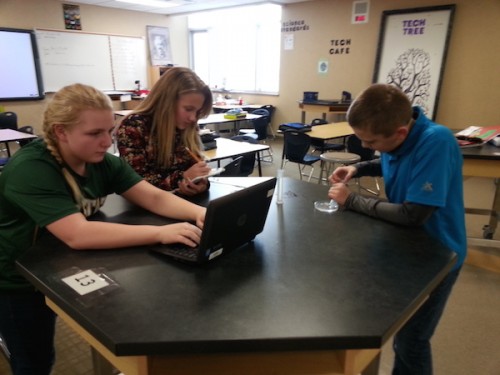
Left to right, Abby Bueling, Skyler Manney, and Jacob Angus. West Fargo SSEP winning team working on their experiment,
Proposal Summary:
Rust during space travel is a problem. Rust weakens metals and makes them vulnerable to other objects in space. That is a problem to space travel because valuable objects may become lost or broken. Conducting an experiment in microgravity could help this by helping engineers prepare for the future. There has been research done on this by the European Space Technology and Research Centre. They have looked at atomic oxygen corrosion in microgravity and have been successful in proving there can be corrosion or rust in a microgravity environment. There are simple factors that save lives and make space travel successful, rust-free chassis is one of them. This experiment could provide answers to the question, “How does rust form differently in a microgravity environment?” This experiment could help future generations save lives and money by making safer exteriors to aerospace crafts. This experiment using Titanium CP 1-Grade 4 in Volume 1 of the MixStix and 0.5% NaCl solution in Volume 2 will investigate how rust forms differently in a microgravity environment. Upon arrival at ISS, crewmembers will open the clamp between the two volumes introducing the metal to the saltwater solution.
HONORABLE MENTION FINALISTS:
Effects of Microgravity on Alcanivorax Borkumensis Decomposition of Oil
Grades 5 and 9, Westside Elementary and Sheyenne High Schools, West Fargo Public Schools
Co-Principal Investigators: Sadiyo Hassan, Tess Schafer
Co-Investigators: Olivia Hettinger, Owen Peterson
Collaborators: Carter Bowsher, Radin Richter, Ariana Sadat, Abigail Smith
Teacher Facilitator: Eric Dobervich
Proposal Summary:
Alcanivorax Borkumensis is a bacterium that thrives in oil spills. It has been used in the Deepwater Horizon Oil Spill in 2010 and worked well to clean up the catastrophe. However, it does have its limits and disadvantages. Not only does it emit harmful carbon dioxide into the atmosphere, it also can’t survive in deep sea waters due to the temperature. This is why an experiment needs to be conducted to test the bacteria’s abilities in a different environment and see how well it decomposes oil in order to come up with a solution so it can perform better on Earth. It’s time to go micro — microgravity that is.
Transfer of Electrons in Microgravity
Grades 5 and 9, Westside Elementary and Sheyenne High Schools, West Fargo Public Schools
Co-Principal Investigators: Alison Ault, Jadyn Voeller
Co-Investigator: Alana Schafer
Collaborators: Allissa Bahnmiller, Kiana Jaeger, Calvin Scoville, Andre Seibel
Teacher Facilitator: Eric Dobervich
Proposal Summary:
Our team, consisting of 9th and 5th graders, has created a question we would like to answer: does a normal battery’s energy content increase, decrease, or stay the same in a microgravity environment? With this question we have designed an experiment that can be sent up to the International Space Station and give us results when it returns to Earth. By using zinc, copper, and lemon juice we will create a small lemon battery in a tube. These three substances can be combined together to create a flow of electrons that is similar to a battery, but has less voltage. All of these substances will be contained in a type 2 FME Mini-Lab. The metals will be in one compartment while lemon juice is in the other. Our team will also be conducting the same experiment on the ground representing the control group. By using a multimeter, we can measure the energy content produced in the lemon battery and compare it to the energy created by our ground experiment. Our experiment would benefit further understanding of electrons in a microgravity environment and expand the knowledge of electricity in space. With this experiment, we are able to answer our question focusing on the change of energy content in a battery.
18. Grant County, Oregon
Jump to Grant County’s Community Profile
SELECTED FOR FLIGHT:
Does Microgravity Affect Variation of the Protein Structure Created?
Grade 9, Grant Union Junior/Senior High School, Grant County Education Service District
Co-Principal Investigators: Zack Deiter, Elijah Humbird, Duane Stokes, Dante Valentine, Cauy Weaver
Teacher Facilitator: Sonna Smith
Proposal Summary:
In their native gravity environment, proteins exist as three-dimensional structures. This experiment is being conducted to find out how microgravity affects the three dimensional structure of the GFP (green fluorescent protein) in E. coli. To conduct this experiment, GFP transformed into the bacteria E. coli will be used. Molecular biologists commonly use the protein synthesizing capabilities of E. coli to express recombinant proteins in the 10-150 kD size range. GFP was chosen because of its barrel shape and strong hydrophobicity and its stability as a protein. Even after the bacterial cells break open the GFP will stay intact for a while or until proteases from the E.coli start chewing them up. The pH of the nutrient broth will be lowered to encourage misfolded proteins. Glycerol will be used because it slows the bacterial growth rate, but does not damage the protein. This experiment is important because if microgravity causes a higher percentage of misfolded proteins, it could cause proteins to send the wrong message signals to cells, possibly causing short or long-term health problems. Misfolded proteins are believed to be the primary cause of Alzheimer’s disease, Parkinson’s disease, Huntington’s disease, cystic fibroses and many other degenerative and neurodegenerative disorders. These diseases and disorders are slow developing and do not generally show symptoms until misfolded proteins have accumulated. Knowing if microgravity contributes to or diminishes the misfolding of GFP could help prevent long-term health problems for astronauts or provide new treatment pathways in the future.
HONORABLE MENTION FINALISTS:
Imbibition of Seeds in Microgravity
Grade 9, Grant Union Junior/Senior High School, Grant County Education Service District
Co-Principal Investigators: Cameron Hallgarth, Wade Reimers, Reagan Shelley
Teacher Facilitator: Sonna Smith
Proposal Summary:
Is imbibition of grass seeds the same on Earth vs. microgravity? Imbibition is how much a seed absorbs water before it begins to germinate. First we will test the experiment on Earth where there is a larger amount of gravity. Then we will send up a test tube with three chambers. In one will be grass seed. In the second will be water. In the third will be formaldehyde. When the experiment is ready to be tested the water will be mixed with the grass seed. After a certain amount of time then the formaldehyde will be mixed with the water and seeds so they will stop absorbing the water and we will be able to see how much was absorbed. The imbibition is important to the seed in microgravity because if the seed absorbs too much water it might rot but if it doesn’t absorb enough it might not germinate right.
Protein Crystallization in Microgravity
Grade 12, Grant Union Junior/Senior High School, Grant County Education Service District
Co-Principal Investigators: Sasha Juarez, Tyler Manitsas, Mariah Meyerholz, Sydney Stearns
Teacher Facilitator: Sonna Smith
Proposal Summary:
The focus of this experiment is to find out how the microgravity effects the formation of protein crystals and how this compares to protein crystals that are formed on Earth. The laws of physical chemistry and thermodynamics control the process of crystallization. Many crystals can be formed with heat, however, heating is not a method of use in protein crystallization because at high temperature the proteins would quickly change or be eliminated. In order for the protein to crystallize, we will need to bring the solution to a supersaturated state. Once we have the protein solution at a supersaturated state, then the crystals should start to form. There are many factors that could affect protein crystallization. This list of 12 factors will help us determine the difference between crystal growth in space and crystal growth on Earth. The factors that could affect protein crystal growth are: 1) pH; 2) ionic strength; 3) concentration of precipitant; 4) concentration of macromolecules; 5) temperature; 6) additives, effectors, and ligands; 7) organism sources of macromolecules, 8) presence of substrates, coenzymes, inhibitors; 9) a reducing or oxidizing environment; 10) metal ions; 11) rate of equilibration; and 12) gravity. These will all have an effect on the protein crystals formation on the space station. We are going to use these to find the difference between the crystals formation at the space station and on Earth.
19. Erie, Pennsylvania
Jump to Erie’s Community Profile
SELECTED FOR FLIGHT:
Using the Statocyst System to Investigate how the Vestibular System Would Provide Orientation and Balance to Living Organisms in Microgravity
Grades 5-8, Iroquois Elementary and Junior-Senior High School, Iroquois School District
Co-Principal Investigators: Aalihya Bowersox, Morgan Schnars
Co-Investigator: Tamara Burton
Collaborators: Brandon Brieger, Jadon Spring
Teacher Facilitators: Lyndsay Foriska, Jennifer Foutz, Shannon Glennon, Andrea Hart, Scott Peterman
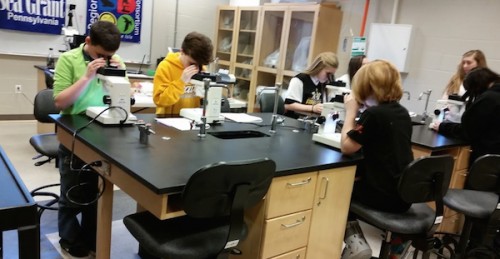
The Erie team working on their experiment at the Tom Ridge Environmental Center. Dr. Jeanette Schnars, Executive Director of the Regional Science Consortium, helps students identify the anatomy of a sea star.
Proposal Summary:
The experiment proposes to test how the Vestibular system in your ear would react in space, by using the statocyst of a sea star. Sea stars were selected because they use a statocyst to maintain equilibrium, which is driven by gravity and is similar to the Otolith organs in your inner ear. If the sea star cannot maintain equilibrium for an extended period of time, it will die. Our null hypothesis is that microgravity will have no effect on the statocyst system and our alternative hypothesis is that microgravity will have an effect on the statocyst system. To test this, three of the sea stars six legs will be trimmed before loading in the mini-lab and the sea stars will be put in a state of dormancy (i.e., refrigeration) until arrival at IS. Upon return to Earth their growth will be measured, and an average growth will be taken for each sea star. If the growth is minimal, then it can be assumed that the sea star had been allocating its energy towards orienting itself and not toward growth and reproduction (bioenergetics). If there is significant growth or reproduction, it can be assumed that the sea star was unaffected by microgravity, and it has minimally been allocating its energy towards orienting itself. The same experiment will run twice on the ground, one experiment will be continually disturbed (rotated), and the other will be undisturbed; since microgravity is the only variable being tested. By further investigating the effects of microgravity, we can better understand the potential stress on the human body in space.
HONORABLE MENTION FINALISTS:
Growth Rate of Skin Cells in Microgravity Compared to Growth Rate on Earth
Grades 5-8, Iroquois Elementary and Junior-Senior High School, Iroquois School District
Co-Principal Investigators: MaryBeth Laney, Leo Nicolussi
Co-Investigators: Thomas Johnson, Isabelle Wilson
Collaborators: Isabella Irwin, Savannah Wisniewski
Teacher Facilitators: Lyndsay Foriska, Jennifer Foutz, Shannon Glennon, Andrea Hart, Scott Peterman
Proposal Summary:
The purpose of this experiment is to see how the growth rate of pig skin cells on Earth compares to their growth rate in microgravity. We predict that the rate of skin cells will grow faster in microgravity then on Earth. We plan to get a pig skin sample, and put the skin sample in the type 3 FME. Volume 1 will contain 3.3 ml of DMEM (cell growth medium) and 0.1 ml of a pig skin sample. This will keep the cells alive until they get to the ISS. Volume 2 of the FME will contain 3 ml of DMEM. This will stimulate the growth of the skin cells. Volume 3 will contain 2 ml of formalin solution (40% formaldehyde). This will kill and preserve the skin cells before they get sent back to Earth. We will then compare the amount of skin from the microcapsule that went to the ISS with the microcapsule from Earth and see the growth difference to make our conclusion. If the skin cells do grow faster in microgravity, then human skin could possibly grow faster also. That will be a valuable break-through for burn patients. With our current treatment for grafting skin it takes weeks, is very expensive, and must be used immediately after it is made. If we could mass produce skin in very little time it would make the price of the procedure and wait time go down, thus reducing the amount of time patients wait for treatment.
Effect of Microgravity on Calypso Bean Germination with Auxin and Cytokinins
Grades 5-8, Iroquois Elementary and Junior-Senior High School, Iroquois School District
Co-Principal Investigators: Haydn Gray, Grace Major, Kaylee Shafer
Co-Investigator: Jeremy Kehl
Collaborator: Alyssa Krochalis
Teacher Facilitators: Lyndsay Foriska, Jennifer Foutz, Shannon Glennon, Andrea Hart, Scott Peterman
Proposal Summary:
Our project will test whether Auxin and Cytokinins will be able to withstand microgravity while facilitating the germination of the Phaseolus Vulgaris (also known as the Black and White Calypso Bean). We plan to design our experiment by placing an FME tube on Earth and in the ISS and simultaneously recording the growth of Calypso Beans to see how the beans germinate with Auxin and Cytokinins in microgravity. The reality of this experiment deals with possible future habitation in space, and explores expediting the time from germination to harvesting. People would need to know a way to make food quickly so they could create a self-sustaining biome. If our plant-growing enhancers can survive in zero gravity then there would be a way to expedite the process of creating nourishment for humans in space.
20. Knox County, Tennessee
Jump to Knox County’s Community Profile
SELECTED FOR FLIGHT:
Effects of Microgravity on the Efficacy of Ciprofloxacin on Escherichia Coli
Grades 7-8, Gresham Middle School, Knox County Schools
Co-Principal Investigators: Keagan Cross, Hanson Lam
Co-Investigators: Molly Hensley, Andrew Starling
Collaborators: Haley Hill, Katherine Redden
Teacher Facilitator: Amelia Brown
Proposal Summary:
Escherichia Coli, more commonly known as E. Coli, is spread through contaminated food or through contact with an infected person or carrier. Some strains are mild, while others can prove to be life threatening. Should this common illness affect astronauts, a prompt recovery would be imperative. An antibiotic can decrease the risk of complications, and eliminate the bacteria. Ciprofloxacin is commonly used, and is what will be used in the experiment. By testing the efficacy in microgravity, we can potentially decrease the risk of this issue. The Ciprofloxacin will be introduced to the E. Coli upon arrival to the International Space Station, and will be compared to results of the ground truth experiment.
HONORABLE MENTION FINALISTS:
The Affects of Colloidal Metals on Mildew in Microgravity
Grade 6, Bearden Middle School, Knox County Schools
Co-Principal Investigators: Alex Hoffman, Riley Speas, William Walker
Collaborator: Riley Wann
Teacher Facilitators: Kayla Canario, David Gornto
Proposal Summary:
We will be using two colloidal substances infusing them into a paper towel, and testing/comparing their mildew rates after exposure to microgravity. We will be using the following factors: a liquid colloidal copper infused Bounty paper towel, liquid colloidal silver infused Bounty paper towel, and water. We will put the paper towel with the liquid colloidal copper on the left side of the tube, and the paper towel with the liquid colloidal silver on the right. Water will be in each side of the tube. Our group has chosen this topic because if we are able to lessen the mildew growth rate in space, then we will be able to store water and clean more efficiently space. NASA is already using colloidal silver in space, but if colloidal copper kills more bacteria than the silver, NASA could use that substance instead of silver.
Analyzing the Affect of Microgravity on the Decomposition of Vegetables
Grade 6, Bearden Middle School, Knox County Schools
Co-Principal Investigators: Luis Alvarado, Moamen Emara, Mauricio Sanchez
Teacher Facilitator: Kayla Canario
Proposal Summary:
We are wondering if we can send sweet potatoes and peas to space. We will put one of the vegetables in one side and the other one on the other side with water in the middle. We will then shake it. When it returns from space, we will check to see which vegetable has more surface area covered in mold.
21. Austin, Texas
Jump to Austin’s Community Profile
SELECTED FOR FLIGHT:
The Growth of Heterotrophic Algae Neochloris oleoabundans in Microgravity
Grade 8, West Ridge Middle School, Eanes Independent School District
Co-Principal Investigators: William Buchanan, Steven Foncerrada, Myles Kovalik, Kyle Shaw
Advisors: Dr. Rhykka Connelly, Dillon Finan, Bobby Levine
Teacher Facilitator: Todd White
Proposal Summary:
The Growth of Heterotrophic Algae Neochloris oleoabundans in Microgravity experiment investigates the effect of microgravity on the growth rate and development of algae. For a long time algae has been used by labs and industries for many products, including cosmetics, nutrition, and most importantly, biofuel. Scientists predict that years from now algae may replace many limited fossil fuel reserves. Algae are also important oxygen producers as they provide two thirds of the Earth’s oxygen. Because of this, the more that is known about the growth of algae, the more the world’s plentiful algae reserves can be used to their greatest extent. In addition, as the prospect of long duration space flight draws nearer, it is necessary to find out whether algae can be grown in these microgravity conditions as a source of fuel, nutrition, and possibly oxygen for future space colonists. The chosen algae are heterotrophic and will grow in the conditions in the mini-lab. The hypothesis is that the algae’s growth rate will accelerate, as gravity isn’t restricting the growth and division of the cells. A freeze-dried sample of the algae will be sent to the ISS, the crew members will provide the algae with water and glucose, beginning the growth process, and after 14 days the crew members will introduce a puromycin solution preserving the results for the return trip back to Earth.
HONORABLE MENTION FINALISTS:
How Does Micro-Encapsulation Differ in Microgravity?
Grade 8, West Ridge Middle School, Eanes Independent School District
Co-Principal Investigators: Will Bundrant, Lucca Cidale, Jason McElhenney, Clark Simpler
Advisors: Dillon Finan, Dawn Mantz, Carol Reese
Teacher Facilitator: Todd White
Proposal Summary:
The focal point of our experiment is to find out how microgravity affects the formation of micro-capsules in space. We hypothesize that the capsules formed in microgravity will have a more spherical and even coating than the ones formed back on Earth. On Earth, the influence of gravity can distort the structure of the capsule, but in a microgravity environment such as aboard ISS, there will be almost perfect conditions. The experiment requires that our core and coating be mixed together on the Space Station so that it may form the capsules. Afterwards, we will open up another seal, which will allow the material that did not encapsulate to filter out into another section. Once the experiment returns back to Earth, we will compare the size, shape, and number of the micro-capsules that were formed on the space station, to the ones formed on Earth. We will use a high-powered microscope from the University of Texas Applied Research Laboratories to analyze the micro-capsules. If the capsules are formed more spherically, then we will know that micro-capsules formed up in space were structurally affected. Microencapsulation is used in many different ways, and if we find out that any of them can work in space, than it could be useful on long-distance space flights, future space colonization, and possibly a “Hail Mary” cure for a growing disease or some problem we might face on Earth.
Ammonia Test Structures in Microgravity
Grade 8, Hill Country Middle School, Eanes Independent School District
Co-Principal Investigator: Avery Johnson
Co-Investigators: Ella Kernaghan, Lauren Luu, Lora Tzolova
Advisors: Dr. David Dorris, Dr. Fabrizio Frontallini, Dr. Mike Kaminske, Dr. Arslan Muhammad
Teacher Facilitator: Woodroe Kiser
Proposal Summary:
Our proposal idea is to place an Ammonia with algae as a food source and 6 mL of seawater in one volume of the fluid mixing enclosure (FME). In the other volume of the FME, we will have 0.5 mL of the fixative formalin. Ammonia is a species of the unicellular marine organism called foraminifera. It has an outer test (shell) made of calcium carbonate which is one of the main reasons we chose this specific organism out of all the many forams. It’s calcium carbonate shell is similar to human bones, and it is a common species which makes it easy to obtain. We would like to see if the Ammonia test structure develops differently in microgravity. This information would help because further research can help people figure out what makes the tests of foraminifera different than human bones. We know that human bones weaken in space, but if foraminifera shells do not react the same way, this information can help find a way to prevent major bone lossin space for astronauts.
22. Burleson, Texas
Jump to Burleson’s Community Profile
SELECTED FOR FLIGHT:
What are the Effects of Hydrogel Polymers when Mixed with Water in Microgravity vs. on Earth?
Grade 5, The Academy at Nola Dunn, Burleson Independent School District
Co-Principal Investigators: Bryston Baker, Westley Mitchell, Kylie Morton, Delaney Storey
Teacher Facilitator: Susan Mundt
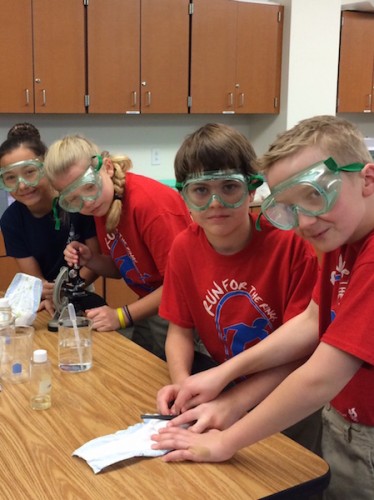
Left to right: Students Delaney Storey, Kylie Morton, Bryston Baker and Westley Mitchell collect and examine polymers to use in their experiment design.
Proposal Summary:
This investigation will study the question of what hydrogel polymers do when mixed with water in microgravity. The hypothesis is that the polymers will absorb more water due to less gravity. Polymers are an important material as they are used in a variety of items on Earth. They are used in credit cards, bottles, spandex, eyeglasses, and first aid packs. It is important to study the polymers and their absorption because this will one day help when families are living on the space station and not just astronauts.
HONORABLE MENTION FINALISTS:
How Does the Chemical Reaction of Rust Differ in Space?
Grade 5, Irene Clinkscale Elementary School, Burleson Independent School District
Co-Principal Investigators: Tyler Anderson, Sam Curtis, Paradise Igwebuike, Drue Saenz
Teacher Facilitator: Eunice Harman
Proposal Summary:
In this proposal we would like to examine the effects of microgravity on Ferrite (Iron) when a mixture of Sodium Chloride (Salt) and H2O (saltwater) is applied to Ferrite (Iron). We would like to perform this experiment for the use of water containers in space and further research for adults. The rusting process is quick and could be dangerous for future space water supply. It is important to find how the chemical reaction of rust reacts to microgravity. For further research in space avoiding rust is crucial for life in space.
How will Mystery Snail Embryos Form in Microgravity vs. on Earth?
Grade 5, The Academy at Nola Dunn, Burleson Independent School District
Co-Principal Investigators: Beau Bavousett, Dan Cardenas, Payton Kvalheim, Braxon Wells
Teacher Facilitator: Amy Kiser
Proposal Summary:
Our mission is to send Mystery snail embryos into microgravity to study early growth patterns. We want to see how the organs are impacted in a microgravity environment. This could lead to the conclusion that human organs could be impacted in the same way. It might help for treating or preventing future health problems on the ISS.
23. Pharr, Texas
Jump to Pharr’s Community Profile
SELECTED FOR FLIGHT:
What is the Effect of Microgravity on the Cell Division of an Onion Root?
Grade 5, Cesar Chavez Elementary School, San Juan-Alamo Independent School District
Co-Principal Investigators: Elva Rodriguez, Yadira Vaca
Advisor: Dr. Anxiu Kuang
Teacher Facilitator: Celena Miller
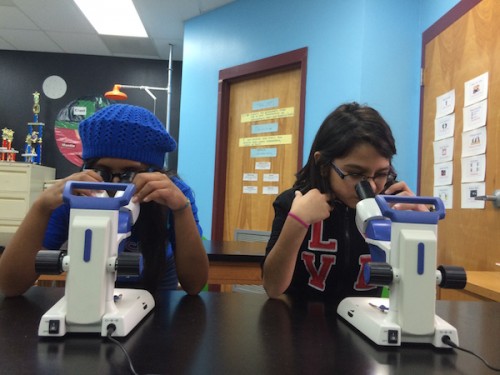
Elva Rodriguez and Yadira Vaca, Cesar Chavez student researchers, observe the cell division of their trial onion root.
Proposal Summary:
The experiment will germinate onion seeds on board the International Space Station (ISS) and on Earth. A Type 3 mini-lab will be used for the experiment. Volume 1 will be filled with 1 mL of distilled water. A cotton ball and three onion seeds will be placed in Volume 2. Volume 3 will contain the fixative glutaraldehyde. Upon arrival on the ISS, the crewmembers will release clamp A of the microgravity experiment and the water will be absorbed onto the cotton ball to begin germination. In the week before undock, the crewmembers will open Clamp B to release the glutaraldehyde to “freeze” the experiment. When the ISS bound experiment is returned to Earth, it will be compared with the ground control, and the observations of the seeds and data will be collected. Observations will include length of roots, observation of cells for mutations, and number of cells samples that are at each stage of mitosis. Root cells of each experiment will be observed under a microscope to determine the number of cells in each phase and if there are any mutations. Will there be changes in the copy of the cell? Will it form a completely new cell or mutate? The hypothesis is that the cells will not be able to divide because they are in microgravity and could possibly mutate. If it is learned that cells have a hard time dividing and mutating in space, this information could have great consequences for astronauts and other future space travelers.
HONORABLE MENTION FINALISTS:
How Does Microgravity Effect the Growth of Bacteria
Grade 5, Cesar Chavez Elementary School, San Juan-Alamo Independent School District
Principal Investigator: Adrian Alvarado
Advisor: Dr. Anxiu Kuang
Teacher Facilitator: Celena Miller
Proposal Summary:
The experiment will focus on bacteria because they play an important role in human health, from digestion to proper immune system function. Because of these important roles, maintaining a spacecraft and the ISS microbe free is neither possible nor desirable. The community of microbes that live in the human body is not simply composed of organisms that are beneficial for human life, but also harbors many bacteria that are potentially capable of causing disease. Will the bacteria grow faster or slower? How will this effect humans in space? “It is essential that we study microbes, their behavior in space, their role on surfaces, and ultimately their potential impact on the health of the astronaut.”
How Does Microgravity Effect the Growth of a Chia Seed?
Grade 5, Cesar Chavez Elementary School, San Juan-Alamo Independent School District
Co-Principal Investigator: Joseph Garza, Marcos Leal
Advisor: Dr. Anxiu Kuang
Teacher Facilitator: Celena Miller
Proposal Summary:
We are conducting this experiment to learn if microgravity affects the growth of a Chia seed. The experiment uses deionized water, cotton balls, and dry Chia seeds. We will be using Type 3 mini-lab. Volume 1 will be filled with 1 mL of distilled water. Volume 2 will have one cotton ball and three dry Chia seeds that will be placed in the center of the cotton ball. Volume 3 will contain a selected fixative to stop the growing process. Two days after arrival at the space station, clamp A will be broken releasing water to begin the germination process. In the week prior to undocking, Clamp B will be unclamped to release the fixative and to preserve the experiment. Upon return from space, observations of the seeds will be done and data will be collected. Observations will include length of stem, observations of roots and stems, and stage of growth. If it is determined that microgravity allows for optimal seed growth, plants could be grown as a renewable food source in space. Plants could also help introduce new oxygen into the space vehicles by recycling carbon dioxide and releasing oxygen. Studying gravitropism will also help to understand how to grow plants in space and find optimal growth. Food supplies will be less of an issue. Future space travelers will be able to travel farther in the solar system and live in space stations for longer periods of time if they travel with their own food.
24. San Antonio, Texas – Northside ISD
Jump to San Antonio’s Community Profile
SELECTED FOR FLIGHT:
The Effects of Microgravity on the Rate of Plant Growth
Grade 12, Business Careers High School, Northside Independent School District
Co-Principal Investigators: Kaitlyn Bloch, John Gonzales
Teacher Facilitator: David Powell
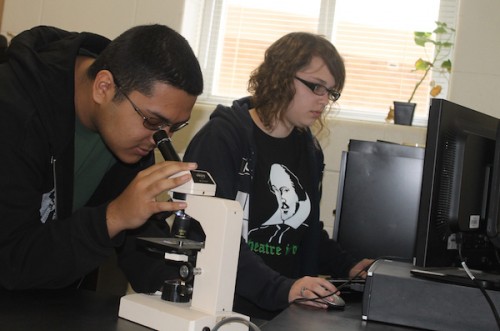
John Gonzales and Kaitlyn Bloch are taking measurements and recording data about their radish seeds in preparation for their experiment.
Proposal Summary:
This experiment will examine the differences in the rate of cell growth and division between a set of radish seeds germinated in microgravity and an identical set of seeds germinated on Earth. The seeds will be kept under the same conditions with the exception of gravity. Upon return to Earth, the seedlings will be cut open and examined under a microscope in order to determine what effect microgravity had on the rate of cell growth and division.
HONORABLE MENTION FINALISTS:
Pill Reaction to Simulated Stomach Acid in Microgravity
Grade 12, William J. Brennan High School, Northside Independent School District
Co-Principal Investigators: Jonathan Dacio, Josh Frey, Nina Valdez
Co-Investigator: Sebastien Gurrero
Collaborator: Josh Broulette
Teacher Facilitator: David Casas
Proposal Summary:
How does Cymbalta work in microgravity? Cymbalta (duloxetine) is a selective serotonin and norepinephrine reuptake inhibitor antidepressant (SSNRI). Duloxetine affects chemicals in the brain that may become unbalanced and cause depression. We want to see if the time release is affected in any way against microgravity. We want to see if the dosage needs to be changed or altered.
The Process of Nitrogen-Fixing Bacteria in Microgravity
Grade 12, Louis D. Brandeis High School, Northside Independent School District
Co-Principal Investigators: Tristen Aguirre, James Garcia
Co-Investigators: Andrea Elizondo, Steven Garcia
Teacher Facilitator: Carrie M. Benson
Proposal Summary:
The following experiment proposal focuses on two fundamental questions. The first question addresses the biological process of nitrogen fixing bacteria in soil and questions if the nitrogen fixation process will produce typical rates of production in the specific and constrictive environment of microgravity. The second fundamental question directly relates to the ability of bacteria to successfully fix nitrogen in microgravity in order to cultivate nutrient rich soil during space flight. The following experiment is designed using a specific type of bacteria known as Azotobacter vinelandii, a free-living, nitrogen-fixing bacteria that does not require a symbiotic relationship with plants or an existing root system to survive or fixate nitrogen unlike other species of diazotrophs. Another unique quality of A. vinelandii is its ability to survive in abnormally harsh conditions by surviving in the form of cysts in soil for up to 24 years when the surrounding environment is depleted in nutrients. This fundamental trait makes this bacteria important because it would not require stringent nutrient rich soil in order to survive in a constrictive environment. Insight learned from this study can provide vital information that could be used to draft critical protocols in cultivating renewable supplies of nutrient rich soil during long duration space flight. This supply of soil can also be maintained using similar procedures as outlined in this study in order to continually provide adequate amounts of soil needed for crop production and/or additional needs during longer duration missions.

